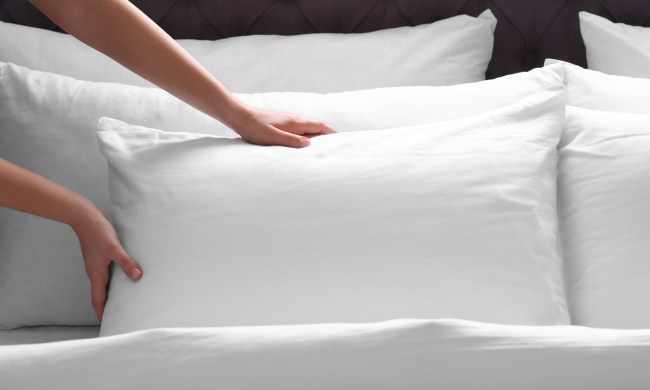The bedroom is the correct temperature, the window coverings make the room dark, and you aren’t using electronic devices right before bed. You’ve purchased the perfect mattress, according to the experts. But you still wake up every morning feeling like you didn’t really get enough sleep.
It might be your pillow.
Correct support for proper sleeping means a good mattress and the right pillow. A flat, crunched-up pillow is not considered good support. Picking out the right pillow is probably a little more complicated than you thought.
Picking a pillow
First, a pillow should be firm enough and thick enough to keep your neck level to your spine. A big, fluffy pillow may look great when the bed is made, but if that fluffy pillow keeps your head at an upward angle, don’t use it for sleeping.
It should be thick enough to fill the distance from your ear to the outside of your shoulder. If you’re a stomach sleeper, you may not need a pillow or just a very soft pillow.
If you sleep on your back, your pillow should be flat enough to keep your neck and head at the same level.
A pillow should give you sufficient support to keep your spine and body in alignment. If the pressure on your shoulders, neck, and head are uneven, you will be tossing and turning all night. You will wake up every morning feeling like your neck was tweaked at an awkward angle.
Most people find a standard-size pillow is just the right size for sleeping. If you use a larger pillow, it should still keep your posture in the correct alignment — neck-level with your spine.
If you have a softer mattress, you may need a firmer pillow.
A little pillow talk
Pillows are filled with different materials. There is down, which is goose or duck fibers. An “all down” pillow actually has feathers, and some may be allergic to down. However, usually it is lower-quality feathers and down that trigger an allergic reaction. Get the best and avoid the sneezes.
Synthetic down and poly fill are less-expensive pillows than down pillows but will need to be replaced more frequently, so that’s the tradeoff. The fill flattens over time. There should be a fill power number on pillows when you are looking at them. The higher the fill power, the better the pillow.
Wool pillows are usually pretty firm, and they resist mold and dust mites. They also draw moisture away from your head and neck to help regulate your temperature while you sleep.
Cotton pillows are naturally hypoallergenic and resist mold and dust mites. They are flatter and firmer than wool pillows.
Latex is firm but comfortable; most contoured pillows are often made of latex. Side sleepers who like to squish their pillows into different positions will not be happy with a latex pillow.
Memory foam conforms to your shape. Your weight and body heat mold the pillow to the shape and lines of your head, neck, and shoulders. But some people complain they retain heat and cause sweating.
Use a pillow case made of natural, breathable fabric to cover your pillow. The pillow cover helps protect the pillow filling, and the case helps extend the life of the pillow. Decorative pillows look great as a finishing touch on the bed, but you should use a regular pillow for sleeping.
When should your pillow be replaced
You should replace your pillows every 18 months or so. That may seem like a lot of new pillows, but you are using that pillow seven to eight hours a night — and that comes to about 2,500 hours a year. So when you think it that way, 18 months doesn’t seem too bad!
Let’s test to see if you need a new pillow. If you fold it in half, does it spring back or just sit there? Springing back is good; sitting flat means get a new pillow. If it’s a down pillow, fold it over your arm. There should be a little bit of “body” and it shouldn’t flop flat. If it does, get a new pillow. And, is it stained and perhaps have a bit of an odor? Also time for a new pillow.
Pillows are an important part of the sleep experience. If you’ve taken care of the atmosphere in your bedroom, you’ve got a great mattress, and you still aren’t sleeping well, change up your pillow.






